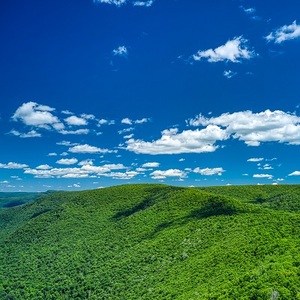

At one time or another most of us have wondered why the sky is blue. The first part of the answer deals with the physics of natural light, while the next deals addresses how natural light reacts when it enters our atmosphere. Without further ado, let's dig into this age-old question.
Natural light is composed of all the different colors of the rainbow. This means that the light that is emitted from the Sun is composed of red, orange, yellow, green, blue, indigo, and violet. Each of these colors has its own wavelength. Red having the longest wavelength while violet has the shortest. This concept is oftentimes illustrated by showing how natural light reacts when it passes through a medium, such as a glass prism. Light bends or refracts when it passes through a prism. Each color bends at different angles upon exiting the prism. A similar thing happens when sunlight passes through raindrops to form a rainbow.
Light not only bends or refracts when passing through different mediums, but it can also be scattered by them. Some mediums are selective as to which color or colors of natural light are scattered. The Earth's atmosphere is composed of 78% nitrogen and 21% oxygen. The size of these molecules determines which color or colors of light will be scattered. Smaller molecules scatter shorter wavelengths of light more efficiently. The size of nitrogen and oxygen molecules are similarly small and therefore scatter wavelengths of light with shorter wavelengths, such as blue and indigo. The scientific term for this is Rayleigh scattering.
We all know the sky becomes a mix of orange or red tones during sunrise and sunset. When the sun is on the horizon, its light passes through a much larger chunk of the atmosphere before getting to us. Due to this, the shorter wavelengths of light such as blue are scattered away before reaching us. This allows the longer wavelengths of light, such as red and orange, to make it to our view. The presence of dust or smoke particulates in the atmosphere will add to the deepness of the red. This is because these particulates are larger and scatter the longer wavelengths of light (red and orange tints) more efficiently.

